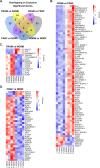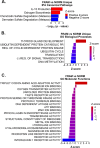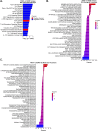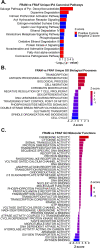Sex-specific transcriptome differences in a middle-aged frailty cohort
- PMID: 35945487
- PMCID: PMC9361278
- DOI: 10.1186/s12877-022-03326-7
Sex-specific transcriptome differences in a middle-aged frailty cohort
Abstract
Background: Frailty is a clinical syndrome described as reduced physiological reserve and increased vulnerability. Typically examined in older adults, recent work shows frailty occurs in middle-aged individuals and is associated with increased mortality. Previous investigation of global transcriptome changes in a middle-aged cohort from the Healthy Aging in Neighborhoods of Diversity across the Life Span (HANDLS) study demonstrated inflammatory genes and pathways were significantly altered by frailty status and race. Transcriptome differences in frailty by sex remain unclear. We sought to discover novel genes and pathways associated with sex and frailty in a diverse middle-aged cohort using RNA-Sequencing.
Methods: Differential gene expression and pathway analyses were performed in peripheral blood mononuclear cells for 1) frail females (FRAF, n = 4) vs non-frail females (NORF, n = 4), 2) frail males (FRAM, n = 4) vs non-frail males (NORM, n = 4), 3) FRAM vs FRAF, and 4) NORM vs NORF. We evaluated exclusive significant genes and pathways, as well as overlaps, between the comparison groups.
Results: Over 80% of the significant genes exclusive to FRAF vs NORF, FRAM vs NORM, and FRAM vs FRAF, respectively, were novel and associated with various biological functions. Pathways exclusive to FRAF vs NORF were associated with reduced inflammation, while FRAM vs NORM exclusive pathways were related to aberrant musculoskeletal physiology. Pathways exclusive to FRAM vs FRAF were associated with reduced cell cycle regulation and activated catabolism and Coronavirus pathogenesis.
Conclusions: Our results indicate sex-specific transcriptional changes occur in middle-aged frailty, enhancing knowledge on frailty progression and potential therapeutic targets to prevent frailty.
Keywords: Aging; Gene expression; Inflammation; Midlife; Musculoskeletal.
© 2022. The Author(s).
Conflict of interest statement
The authors declare that they have no competing interests.
Figures





References
-
- Fried LP, Tangen CM, Walston J, Newman AB, Hirsch C, Gottdiener J, Seeman T, Tracy R, Kop WJ, Burke G, et al. Frailty in older adults: evidence for a phenotype. J Gerontol A Biol Sci Med Sci. 2001;56(3):M146–156. - PubMed
Publication types
MeSH terms
Grants and funding
LinkOut - more resources
Full Text Sources
Medical
Molecular Biology Databases

